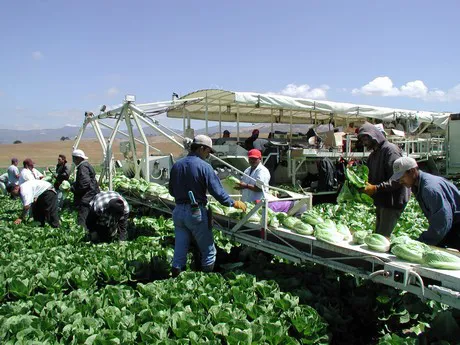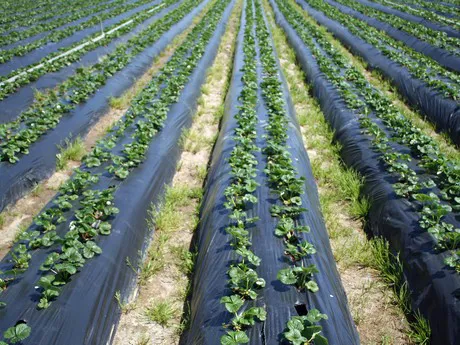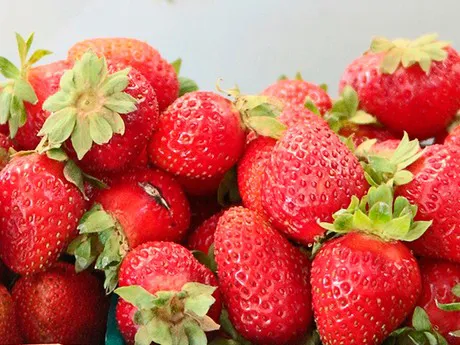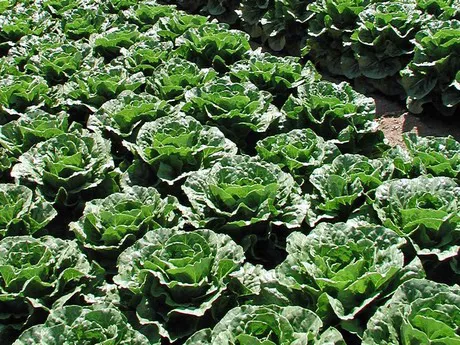UC ANR Agricultural Issues Center and UC Cooperative Extension have released sample costs to produce and harvest organic strawberries for fresh market and romaine lettuce hearts in Santa Cruz and Monterey counties.

Romaine harvest. In the romaine and strawberry cost studies, the authors have also expanded the section on labor, which includes information on California's minimum wage and overtime laws.
Farmers who are considering growing romaine hearts or organic strawberries in California's Central Coast region can get some help determining whether the crop will pencil out for them.
A major difference between growing strawberries organically and the conventional practice is in weed control.

“Weed management is especially challenging for organic strawberry production because soil fumigation and most herbicides are not allowed under organic regulations,” said Mark Bolda, UC Cooperative Extension farm advisor in Santa Cruz County. “Weeds in furrows between the beds can be mechanically cultivated during the growing season, but most of the weeding will need to be done by hand from December through September.”
The cost analyses are based on hypothetical well-managed farming operations using practices common to the Central Coast region. The costs, materials and practices shown in the studies will not apply to all farms and are intended to assist growers in estimating their own costs.

Fresh organic strawberries are harvested by hand and packed into 1-pound plastic containers.
The organic strawberry study assumes a farm with conventionally grown strawberry transplants planted on 27 contiguous acres of rented land. “Organic strawberry transplants are part of the picture now, but not standard by a long shot,” said Bolda, who co-authored the cost studies. The strawberry crop is harvested by hand and packed into trays containing eight 1-pound clamshells, from April through early October with peak harvest in June and July.
For romaine lettuce for the hearts market, the cost study assumes a farm of 1,500 non-contiguous acres of rented land, with romaine planted on 250 acres and rotated with other lettuce and cool season vegetable crops to assist with pest management and soil fertility. Lettuce is planted continuously from late December to mid-August along the Central Coast. To manage lettuce mosaic virus, Monterey County has a host-free period (December 7 – 21), during which time lettuce may not be planted. In this study, lettuce is planted in January.

Romaine is rotated with other lettuce and cool season vegetable crops to assist with pest management and soil fertility.
For both the organic strawberries and romaine, ranging analysis tables show net profits over a range of prices and yields. Other tables show the monthly cash costs, the costs and returns per acre, hourly equipment costs, and the whole farm annual equipment, investment and business overhead costs. The authors describe the assumptions they used to identify current costs for production material inputs and overhead.
The authors have also expanded the section on labor, which includes information on California's minimum wage and overtime laws.
Growers, UC ANR Cooperative Extension farm advisors and other agricultural associates provided input and reviewed the methods and findings of both studies.
Free copies of these and other sample cost of production studies for many commodities are available. To download the cost studies, visit the UC Davis Department of Agricultural and Resource Economics website at https://coststudies.ucdavis.edu.
For more information about calculations used in the romaine hearts and organic strawberries studies, contact the Agricultural Issues Center at (530) 752-4651 or Mark Bolda at UC Cooperative Extension in Santa Cruz County at (831) 763-8025.
The cost and returns studies program is funded by the UC Agricultural Issues Center and UC Cooperative Extension, which are part of the UC Division of Agriculture and Natural Resources, and the UC Davis Department of Agricultural and Resource Economics.
